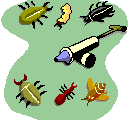Adaptations
Trying to get along
Viola odorata has adapted in means of reproduction by having Formica polyctena ants disperse their seeds. To find out more about their seed dispersal see How do I reproduce?

Viola odorata are not alive all year. They usually bloom in the spring, but some do not bloom until into the summer. Their prime flowering months are from March to May. However, they are perennials meaning they come back year after year. For more information on the perennial aspect of Viola odorata see How do I reproduce?
Viola odorata is usually between three to eight inches tall. The leaves of
Viola odorata are usually dark green, large, hairy and
commonly heart shaped.
 The leaves are basal and have their blossoms on
separate stalks from their leaves.
The plant's blossoms all have five sepals, five stamens and five
petals. Their flowers are
usually deep purple, white or pale mauve and they have a subtle scent.
The leaves are basal and have their blossoms on
separate stalks from their leaves.
The plant's blossoms all have five sepals, five stamens and five
petals. Their flowers are
usually deep purple, white or pale mauve and they have a subtle scent.
Another adaptation is that
 Viola odorata uses a
novel suite of cyclotides.
Viola odorata uses a
novel suite of cyclotides.
